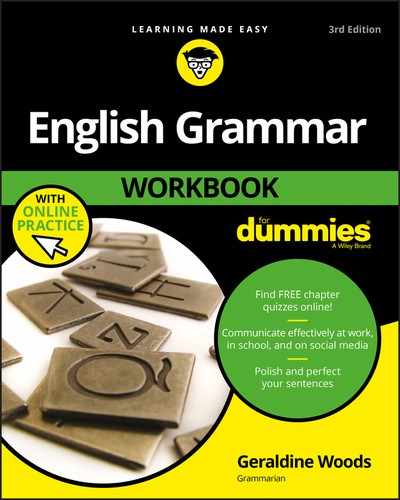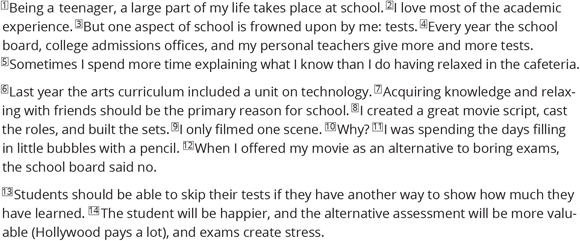Appendix
Grabbing Grammar Goofs
How sharp are your eyes? This appendix is the grammatical equivalent of an optometrist’s chart. If you can see it with 20/20 vision, you’ll spot 30 mistakes in each of the first four exercises. Of course, after you spot the errors, your mission is to correct them. The errors may involve faulty structure or word choice, punctuation, capitalization, and anything else the English Grammar Workbook For Dummies, 3rd Edition covers.
Spotting and correcting errors prepares you for standardized writing tests. The last two exercises in this chapter go even further by mimicking a common format. If you’re preparing for one of those tortures — sorry, exams — these exercises will help. Even if you aren’t sharpening No. 2 pencils for the SAT, the ACT, or a similar challenge, you can still improve your grammar and writing style by working through exercises seven and eight.
Exercise One
Sneak a peek at the college catalogue (from a university that exists only in my mind) in Figure A-1. This course description has many faults — 30, by my count. Your count may differ slightly depending on how you group your answers. Don’t worry about numbers — your mission is to search and destroy the mistakes.

FIGURE A-1: A scary sample course description that needs some work (in more ways than one).
Exercise Two
This letter from a made-up publisher, in Figure A-2, is full of errors. Try your hand at correcting all 30.

FIGURE A-2: A sample letter from a publisher (with a lot of mistakes, so you know it must be fake).
Exercise Three
Try your hand at editing the newspaper article in Figure A-3. You should find 30 errors, including some in the quoted material. (If you’re quoting someone who makes a grammar error, you may usually leave the error in the quotation in order to convey the speaker’s style or personality. For the purposes of this exercise, however, correct every mistake.)
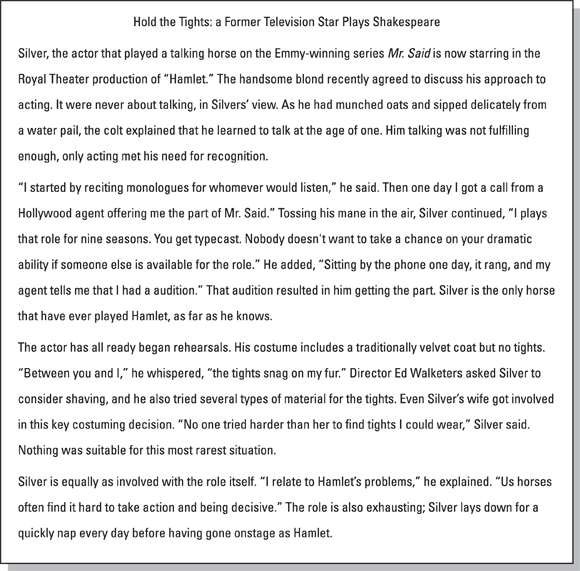
FIGURE A-3: A sample newspaper article with a plethora of errors.
Exercise Four
Don’t you hate computer manuals? The one in Figure A-4 is even worse than the usual techno-babble because it contains 30 mistakes. Correct them!
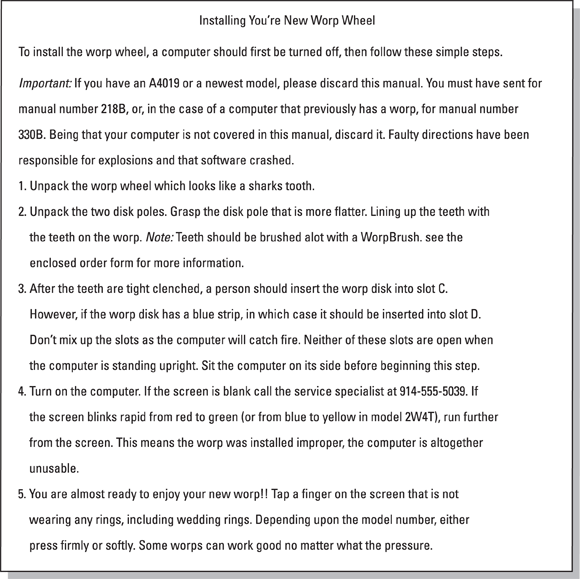
FIGURE A-4: The world’s biggest headache inducer: A sample of a poorly written computer manual.
Exercise Five
If you’re a high school student, sooner or later you’re likely to encounter a reading passage that tests your grammar skills. Standardized tests, such as the SAT and the ACT, hit you with multiple-choice questions about a paragraph desperately in need of revision. If your school days are in the rear-view mirror, you can still sharpen your editing skills with this exercise, which resembles what you may encounter in standardized testing (but with a little humor thrown in).
Directions: Following this student essay are six questions. Choose the best answer.
121 Which of the following is the best revision of Sentence 1?
(A) No change.
(B) Being a teenager, most of my life happens at school.
(C) Being a teenager, I spend a large part of my life at school.
(D) A large portion of every teenager’s life takes place at school.
122 How may Sentences 2 and 3 be combined most effectively?
(A) No change.
(B) I love most of the academic experience, but tests are frowned upon by me.
(C) Accept for tests, I love most of the academic experience.
(D) I love most of the academic experience, but I frown upon tests.
123 How should Sentence 5 be revised?
(A) No change.
(B) Sometimes I spend more time explaining what I know, than I do relaxation in the cafeteria.
(C) Sometimes I spend more time explaining what I know than relaxing in the cafeteria.
(D) Sometimes I spend more time having explained what I know than I do having relaxed in the cafeteria.
124 Sentence 7 should
(A) remain where it is
(B) be deleted
(C) be moved to the end of the second paragraph
(D) be moved to the end of the third paragraph
125 Which of the following is the best revision of Sentence 9?
(A) No change.
(B) I filmed only one scene.
(C) Only I filmed one scene.
(D) I did film only one scene.
126 To improve this essay, what should be done with the third paragraph (Sentences 13 and 14)?
(A) No change.
(B) Delete Sentence 14.
(C) Add an additional example of a useless test.
(D) State that this essay represents the author’s opinion.
Exercise Six
If you plan to fill little ovals with pencil lead anytime soon — or even if you don’t — you can hone your writing skills with this exercise, which is set up in the same format you may meet on a standardized test. Read the essay and answer the questions that follow. Note: This essay is a little silly in terms of subject matter, but the questions are serious. And so are the SATs and ACTs and the rest of the “alphabet soup” of exams!
Directions: Following this student essay are six questions. Choose the best answer.
127 Which of the following, if any, is the best revision of Sentences 1 and 2?
(A) No change.
(B) Omit “that” from Sentence 1.
(C) Place Sentence 2 before Sentence 1.
(D) Delete Sentence 2.
128 In the context of this essay, which sentence, if any, would be a good addition to the first paragraph?
(A) No change.
(B) Self-definition is a lifelong task.
(C) No one really understands his or her own identity.
(D) Identity is a private matter.
129 What is the best revision, if any, of Sentence 6?
(A) No change.
(B) Your society which you had lived in also gives you a definition.
(C) The society, in which you will have lived, also gives you a definition.
(D) The society in which you live also defines you.
130 To improve Sentence 8, what should the writer do?
(A) No change.
(B) End the sentence after “cafeteria.”
(C) Delete the words between the commas.
(D) Change “was beginning” to “had begun.”
131 Which is the best revision, if any, of Sentence 14?
(A) No change.
(B) I gave free pizza to whoever will promise a vote for me.
(C) I gave free pizza to everyone who promised to vote for me.
(D) Giving free pizza, everyone promised to vote for me.
132 What change, if any, would you make to this essay?
(A) No change.
(B) Mention politics and pizza in the first paragraph.
(C) Insert additional examples of choices in the first paragraph.
(D) Place Sentences 16 and 17 in a concluding paragraph, expanding on the ideas they contain.
Answers to Exercise One
In the following figure the errors from the original course description are boldfaced and crossed out, with a possible correction following each one, as well as an occasional addition of a missing word or mark. All corrections are boldfaced and underlined. Check the corresponding numbered explanations that follow the revised course description.

1 The subject is three periods, a plural, so the verb (are) must also be plural.
2 The subject course is singular, so the verb (involves) must also be singular.
3 To keep the sentence parallel, the noun lecture should be coupled with another noun, not with a subject/verb combo.
4 The practical application is simultaneous to the learning, so future tense isn’t what you want. Go for present (learn).
5 The paragraph refers to students (plural), so a shift in one spot to singular is inappropriate. Also, in formal English, a singular noun (a student) doesn't pair with a plural pronoun (their). This rule is evolving, and “their” is increasingly accepted as a match for a singular noun. Changing “A student” to “Students” ensures that all readers see this sentence as correct in Standard English.
6 The original sentence includes the possessive peasants’ for no valid reason. The possessive form should be linked to a noun, but here it precedes a verb form (oppressed).
7 In titles, articles (such as the in this title) shouldn’t be capitalized.
8 When a comma follows quoted material, the comma is placed inside the closing quotation mark.
9 In the original sentence the pronoun this is vague. Insert the clarifying expression reading list.
10 The contraction who’s means “who is,” but the sentence calls for the possessive whose.
11 Items in a series are separated by semicolons only when one or more of the items contain a comma. In this series, no item contains a comma, so semicolons aren’t necessary.
12 A future deadline (by the time the course concludes) calls for future perfect tense (will have gathered).
13 To make a list parallel, all items must have the same grammatical identity. In the original list, you have two nouns and one subject-verb combo. Change the subject-verb combo to another noun, “media manipulation,” and the problem is solved.
14 The original sentence contains a dangler, working in the field. An introductory element containing a verb form must refer to the subject, and spy networks aren’t working in the field. Reword the sentence so that the students are working in the field.
15 Two complete sentences may not be joined by a comma. Substitute a semicolon or make two sentences.
16 The pronoun this is too vague all by itself. In the original, this may refer to setting up spy networks or recruiting foreign agents. Change this to fieldwork and the sentence is clear.
17 To create a possessive form for a plural ending in the letter s, just add an apostrophe, not an extra s.
18 The student is in the course and so must be compared to everyone else.
19 In the original, this misplaced description seems to say that a country is required for graduation, not the task. Descriptions should be close to the word they describe.
20 The plural subject, exams, requires a plural verb, emphasize.
21 The description practical should be intensified by an adverb (really), not by an adjective (real).
22 If you unite two complete sentences with the word and, a comma precedes the and. If you unite two of anything else (in this sentence, two nouns — skills and ideas), no comma precedes the and.
23 The descriptive word only should precede the word being compared — in this case, only two as compared to three or four or whatever the professor assigns.
24 Possessive pronouns have no apostrophes.
25 Admission is singular and takes a singular verb, is.
26 The adjective Political describes the noun Science. Politically is an adverb and may describe only verbs (speaking politically) or other descriptions (politically inexperienced).
27 A statement should end with a period, which is missing in the original.
28 Irregardless isn’t Standard English though it is increasingly popular in conversational English. Because this text appears in an official document (a course description), formal English is better. Substitute regardless.
29 As and than don’t belong in the same comparison. An as comparison is for equal items and a than comparison for unequal items.
30 Try and implies two actions, but the sentence refers to one that should be attempted. The proper expression is try to.
Answers to Exercise Two
In the following figure the errors from the original letter are boldfaced and crossed out, with a possible correction following each one, as well as an occasional addition of a missing word or mark. All corrections are boldfaced and underlined. Check the corresponding numbered explanations that follow the revised letter.
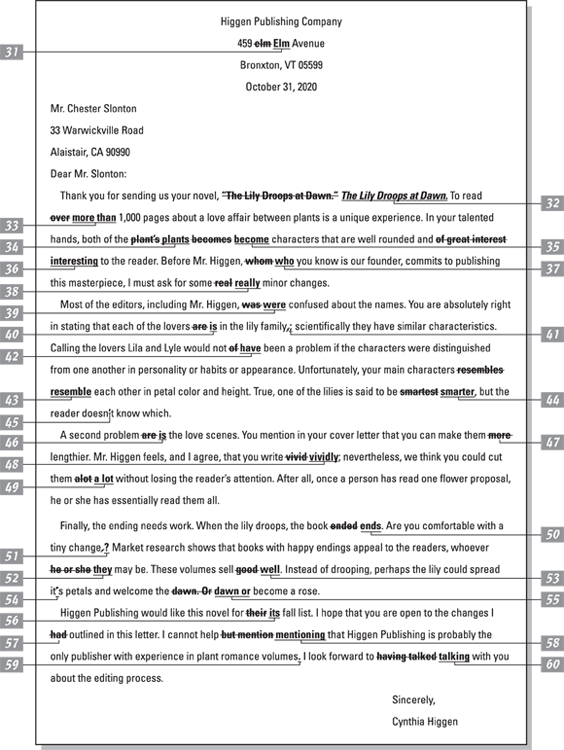
31 Proper names are capitalized.
32 The title of a full-length work (in this case, a novel) is italicized or underlined, not enclosed in quotation marks.
33 Over precedes a singular word, and more than precedes a plural.
34 Plants is a plural, not a possessive, so no apostrophe should appear.
35 Both is plural and should be matched with the plural verb become.
36 The original sentence isn’t parallel because it pairs the simple description well rounded with the phrase of great interest. The correction changes the phrase to a simple description, interesting.
37 The pronoun who is needed to act as a subject for the verb is.
38 Real is an adjective and appropriate for descriptions of people, places, things, or ideas. The adverb really intensifies the description minor.
39 Most of the editors is a plural subject and requires a plural verb, were.
40 Each of the lovers is a singular subject and requires a singular verb, is.
41 A comma may not join two complete sentences. Use a semicolon instead.
42 Would of doesn’t exist in Standard English. The proper expression is would have, here changed to the negative would not have.
43 The plural subject characters needs the plural verb resemble.
44 Smartest is for the extreme in groups of three or more. Because only two lilies are compared, smarter is correct.
45 The contraction doesn’t contains an apostrophe.
46 The singular subject problem takes the singular verb is.
47 Double comparisons aren’t correct. Use lengthier or more lengthy.
48 The verb write may be described by the adverb vividly but not by the adjective vivid.
49 The expression a lot is always written as two words.
50 The present-tense verb ends works best with the rest of the sentence, which contains the present-tense verb droops.
51 This sentence, a question, calls for a question mark instead of a period.
52 The plural pronoun they refers to readers.
53 Good is an adjective, but the sentence calls for the adverb well to describe the verb sell.
54 A possessive pronoun, such as its, never includes an apostrophe.
55 The expression or become a rose is a fragment and may not stand as a separate sentence.
56 A company is singular, so the matching pronoun is its.
57 The helping verb had is used only to place one action in the past before another past action.
58 Cannot help but mention is a double negative.
59 Every sentence needs an endmark. This statement calls for a period.
60 Having talked implies a deadline, and the sentence doesn’t support such a meaning.
Answers to Exercise Three
In the following figure the errors from the original article are boldfaced and crossed out, with a possible correction following each one, as well as an occasional addition of a missing word or mark. All corrections are boldfaced and underlined. Check the corresponding numbered explanations that follow the revised article.

61 The first word of a title and a subtitle should always be capitalized.
62 Silver identifies the horse being discussed. The original sentence has a comma at the beginning of the long, descriptive expression (the actor who played a talking horse on the Emmy-winning series Mr. Said) but none at the end. The second comma is necessary because the information supplied is extra, not essential to the meaning of the sentence. It should be set off from the rest of the sentence by a pair of commas.
63 The title of a full-length work (in this sentence, a play) should be in italics or underlined.
64 The singular it pairs with the singular verb was.
65 A singular possessive is formed by the addition of an apostrophe and the letter s.
66 The helping verb had places one past action before another past action, but in this sentence the actions take place at the same time. Drop the had.
67 The possessive pronoun his should precede an -ing form of a verb that is being used as a noun (in this sentence, talking).
68 Two complete sentences shouldn’t be joined by a comma. Use a semicolon instead.
69 The subject pronoun whoever is needed as the subject of the verb would listen. The preposition for may have confused you because normally an object follows a preposition. However, in this sentence the entire expression (whoever would listen) is the object of the preposition, not just the pronoun.
70 A quotation mark belongs at the beginning and the end of the quotation.
71 The past tense verb matches the meaning of the sentence.
72 The pronoun nobody is singular and requires a singular verb, wants.
73 In summary of speech, past tense works best. Tells is present tense. Told is past tense.
74 In the original sentence, it (the phone) is sitting by the phone — illogical! Reword in some way so that the speaker is sitting by the phone. Another possible correction: Add a subject/verb combo to the beginning of the sentence so that it begins “When I was sitting by the phone.”
75 Before a noun beginning with a vowel sound, audition, you need an, not a.
76 The possessive pronoun his should precede the -ing form of a verb that is being used as a noun (in this sentence, getting).
77 Because only one horse is the meaning of the pronoun that, the verb paired with that is singular. Has is singular, and have is plural.
78 The single word already means “before this time,” the meaning required by the sentence.
79 Begun is the form of the verb to begin that is used with a helping verb. Here it’s paired with has.
80 The adjective traditional describes the noun coat.
81 Between is a preposition and thus takes an object. The pronoun me is an object.
82 Two males appear in the sentence (Silver and Ed), so the pronoun he is unclear. Substitute a noun.
83 The missing word in the original is did, as in than she did. Her is inappropriate as the subject of the implied verb did.
84 Both most and rarest express the same meaning. You don't need both. Delete most and the error is fixed.
85 The comparison equally should not be followed by as.
86 We is the subject pronoun needed here. Us is for objects.
87 To keep the sentence parallel, to be should be paired with to take action.
88 To lay is “to place something else somewhere.” To lie is “to rest or to recline,” the meaning here.
89 The noun nap must be described by an adjective (quick), not an adverb (quickly).
90 The sentence is in present tense, and two actions are mentioned — lies and having gone. See the mismatch? Change having gone to going and you stay in the present, the best tense for habitual actions.
Answers to Exercise Four
In the following figure the errors from the original manual are boldfaced and crossed out, with a possible correction following each one, as well as an occasional addition of a missing word or mark. All corrections are boldfaced and underlined. Check the corresponding numbered explanations that follow the revised manual.

91 The contraction you’re means “you are.” In this sentence you want the possessive pronoun your.
92 An introductory verb form (To install the worp wheel) must refer to the subject, but the subject in the original sentence is a computer. Reword the sentence so that the subject is the person who is installing — the understood you.
93 The adverb then is not capable of uniting two complete sentences on its own. Delete the comma and insert and.
94 The -est comparison singles out one extreme from a group of three or more. In this sentence you’re talking about a comparison between two things only — model A4019 and the group of everything newer. (The group counts as one thing because the items in the group aren’t discussed as individuals.)
95 The verb send is in present tense and addresses what the installer must do now, not what the installer must have done previously. The present perfect tense (have sent) implies a connection with the past.
96 The word previously tips you off to the fact that you’re talking about past tense, so had works better than has.
97 The expression being that is not standard; use because instead.
98 The pronoun it must have a clear meaning, but the original sentence provides two possible alternatives, computer and manual. The correction clarifies the meaning of it.
99 Two terms linked by and need a similar grammatical identity in order to keep the sentence parallel. The original sentence joins a noun (explosions) with a clause (that software crashed). The correction links two nouns, explosions and crashes.
100 A description beginning with which is usually set off by a comma from the word it describes.
101 The tooth belongs to the shark, so you need the possessive shark’s.
102 More flatter is overkill. The -er form creates the comparison, and so does more. You can't use both terms in one comparison. The easiest correction is to cross out more. You can also keep more and change flatter to flat.
103 The original sentence is a fragment; it has no complete thought. The correction has a subject (the understood you) and a verb (line) and a complete thought.
104 The expression a lot is always written as two words.
105 A sentence always begins with a capital letter.
106 Tightly is an adverb, needed to describe the verb clenched.
107 A person is a new expression in this piece, which has been addressing you either directly or by implication. For consistency, change a person to the understood you.
108 The original is a fragment, not a complete sentence. The reworded version has a complete thought.
109 The pronoun neither is singular and takes the singular verb is.
110 Sit is what the subject does by bending knees and plopping onto a chair. Set means that you’re placing something else into some position.
111 An introductory expression with a verb is usually set off by a comma from the main idea of the sentence. Insert a comma after blank.
112 The adverb rapidly is needed to describe the action blink.
113 Farther is for distance, and further is for time or intensity. Here you need the distance word.
114 The pronoun this is too vague. Go for the specific term, blinking.
115 The adverb improperly is needed to describe the action installed.
116 A comma isn’t strong enough to link two complete sentences. Dump the comma and insert a semicolon.
117 Don’t double up on endmarks. One per sentence does the job.
118 The description is in the wrong place in the original sentence. Place it after hands, the word being described.
119 The duo either/or should link words or expressions with the same grammatical identity. In the original sentence, a verb-description combo is linked to a description. Move either so that two descriptions are linked.
120 The adverb well is needed to describe the verb can work.
Answers to Exercise Five
If this were a real standardized test, by now you’d be sleeping and a machine the size of a small country would be scanning your answers and tallying your score. Sadly, here you have to check your own work. The payoff is that the explanations reinforce some important points about writing.
121 C. The original sentence contains a description attached to the wrong word. The introductory verb form (Being a teenager) must describe the subject, but in the original it’s attached to a large part of my life. Choice (C) fixes the problem by changing the subject. Did I catch you with (D)? Grammatically it’s fine, but because the rest of the paragraph is in first person (the I form), the first sentence should be also.
122 D. The switch from active voice (I love) to passive (is frowned upon) isn’t justified. Choices (C) and (D) stay active, but (C) misuses a word. Accept is “to receive freely.” The word that rules something out is except. Therefore, Choice (D) is the best answer.
123 C. The original sentence isn’t parallel because explaining is paired with having relaxed. Choice (C) corrects the parallelism error and keeps the correct tense — present — because the author is discussing an ongoing, current situation.
124 D. Sentence 7 is a general statement that explains why tests are a pain and socializing is fun. You may use it in the first paragraph (not an option in the answer list) or in the third paragraph, which is where Choice (D) places it, because the introduction and the conclusion discuss the same ideas.
125 B. The description only should precede the comparison. Here the writer is talking about one scene, not many scenes or the whole movie, so only belongs in front of one. The tense change in Choice (D) isn’t justified by the meaning of the sentence.
126 A. Surprised? The last paragraph of this essay is the conclusion, explaining the author’s point of view. You don’t need to label it as opinion — Choice (D), because the reader already knows. Why else would the writer make these statements? Nor do you need additional examples or a different order. The conclusion could be expanded by adding a statement reinforcing the ideas in the essay (Sentence 7, for example), but the answer choices don’t include that option.
Answers to Exercise Six
Last but not least, here are the answers that belong to this lovely essay on the virtues of being oneself. Take a look at the answers and explanations to see whether you found all the errors — grammatical errors, that is. I’ll let you figure out what else this writer is doing wrong. Buying votes is just a start!
127 B. When you introduce a quotation with a speaker tag (A wise man once said), the tag is followed by a comma and the first word in the quotation is capitalized. A quotation introduced by that has no comma and no capital letter, unless of course the first word is a name. In this case, dropping that solves both the capital letter and the comma problem.
128 A. The first paragraph is short, but it does the job of introducing the ideas in the essay. The other choices are off-topic.
129 D. Context tells you that the time period of this sentence is the present. Therefore, you need the present-tense verb live, not the past-tense verb lived.
130 B. By the time you get to cafeteria, you already know that the writer is enrolled (and presumably studying) in that school. Why add extra words?
131 C. You can’t promise voting, only to vote or a vote. Therefore, the original doesn’t work. Choice (B) falls apart because the first verb, gave, is in past tense. It doesn't pair well with the second, future perfect verb, will have promised. Choice (D) fails because the introductory verb form (Giving) must describe the subject, and everyone isn’t giving pizza. Choice (C) is the answer you seek.
132 D. Essays should be focused, so adding examples at random to paragraph one doesn’t work. Nor does deleting the first paragraph, as it serves a purpose: to set the stage for the anecdote in the second paragraph. What’s missing is a true conclusion. The closest thing this essay has to a conclusion is the last two sentences. Give them their own paragraph and expand on the ideas to create a stronger ending.
